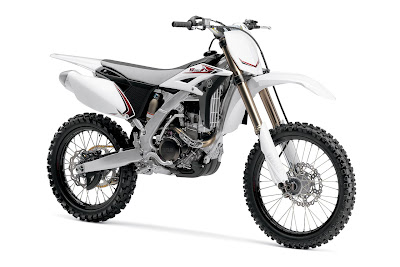The Yamaha YZ250F is hitting dealer floors in 2012 with a host of beefy upgrades to the nimble motocrosser. New design elements are found throughout the frame, engine, suspension and gearing giving the YZ250F an overhaul for the upcoming year.
Yamaha first started with the frame by adding a three-box tank rail section instead of its original two-box design for increased rigidity. The frame design also includes a new swingarm pivot point and new engine brackets for more predictable handling.
Housed within the new frame design is a re-worked engine. Yamaha opted for a lighter piston, piston pin and wire circlip. Yamaha claims the new piston gives better performance by reducing overall mass and friction, providing more power from 8000-12,000 rpm. Yamaha engineers also took into account vibration on the 250F, revising the crankshaft balancer to reduce the vibes felt at several key touchpoints including the handlebars, seat and footpegs. In addition, the balancer shaft is now optimized for the lighter piston, which further reduces vibration.
Biggest news for the 2012 model is what’s not changed, as the YZ remains the lone 250 to shun electronic fuel injection. Yamaha did tweak the carburetor, however, boring it out another 2mm, and a high-flow air filter cage has been fitted inside the 250F to enhance top-end performance. CDI settings have also been reformatted to give the bike better throttle response in the mid to high-speed range, and a new silencer with a smaller outlet is designed to meet AMA Pro Racing sound regulations.
Up front the KYB Speed Sensitive System fork is revalved and is now offset by 22mm. The outer tube has also been enhanced for 50% more rigidity, and the steering stem was made longer. The spring rate on the fork is now 0.46kg. The 250F’s rear shock sees new rebound damping and a new swingarm adds more strength to the axle block. Yamaha touts that these changes add more refined damping character and improve bump absorption, allowing for more aggressive sessions on the track.
news new and review about motorcycle
Popular Posts
-
The 2011 Aprilia RSV4 Factory APRC-SE created with the single-minded goal of being simply the best on the track and on the road, since its ...
-
The 2011 Honda Stateline VT1300CR Stateline is a motorcycle that grabs your attention and won't let go. The 1,312 cc V-twin engine uses...
-
The 2012 Ducati Diavel Cromo , flawless shine of the chromium plated tank, which contrasts starkly yet stylishly with the gloss black, give...
-
The 2011 Honda CBR125-R SOHC four-stroke engine delivers excellent low-end and midrange power that makes getting going from a stop super ea...
-
The 2011 Piaggio Scooter Fly 150 inherits Piaggio's tradition of success, using the latest scooter technology and design trends. The r...
-
Based on the 1948 Chief, the 2012 Indian Chief Vintage two-tone color schemes, and fender light take you back to the era where the Indian C...
-
The 2011 Harley-Davidson FLTRUSE CVO Road-Glide-Ultra , a super-premium touring motorcycle, offers its rider and passenger exceptional style...
Copyright © 2013.
New Motorcycle
- All Rights Reserved











0 Comments :
Post a Comment